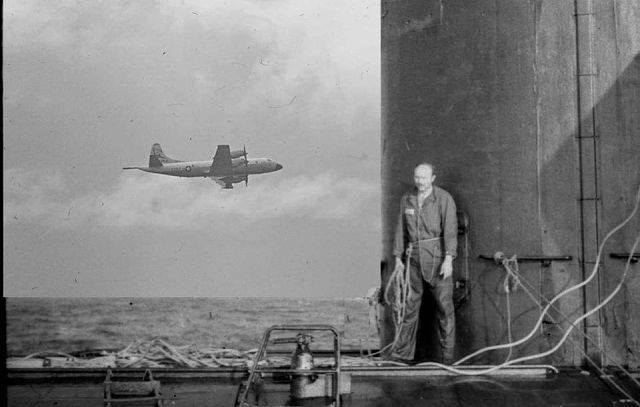Today in 1955, a specially-modified B-36 bomber—the NB-36H—made its first test flight out of Carswell AFB, Texas, carrying (but not powered by) an operational 1-Megawatt air-cooled nuclear reactor. It would make 46 additional flights over Texas and New Mexico through March 1957. 

The NB-36H flew directly over Lake Worth, the principal water source for Fort Worth. A B-50 carrying specially-trained paratroopers escorted each test flight. Had the NB-36H crashed, they would jump into the impact zone to prevent any unauthorized entry.
A 12-ton lead-and-rubber-shielded cockpit with windows 10-12 inches thick protected the flight crew from the otherwise lethal amount of radiation emanating from the reactor hanging in the bomb bay. Special water pockets installed aft of the cockpit also absorbed radiation. 



Even with all that shielding, the Air Force only recruited NB-36H test pilots who were beyond child-rearing age. And because of weight constraints, no attempt was made to shield the considerable emissions from the top, bottom, or sides of the reactor.
https://twitter.com/wellerstein/status/511275915549376513?s=20
The Aircraft Nuclear Propulsion program—originally Nuclear Energy for the Propulsion of Aircraft—was canceled in 1961 after 15 years of research and development and the expenditure of more than $11 billion (in today's dollars). In the end, no plane ever flew under nuclear power.
However, not long before ANP was canceled, a massive 90,000-square-foot reinforced concrete Flight Engine Test Facility and hangar was built in 1959 at the Nuclear Reactor Test Station in Idaho at a cost of $59 million in today’s dollars (a planned 15,000-foot runway was not). 



Refusing to see the writing on the wall, the Air Force Special Weapons Center also issued a contract in 1959 to purchase the gigantic "Beetle" (named for its nimble, pincer-like "claws") to maintain and refuel a fleet of nuclear-powered bombers. It was delivered in 1961. 



Built by Jered Industries for General Electric's Nuclear Materials and Propulsion Operation division, the Beetle was 19' long, 12' wide, 11' high (but able to extend up to 27'), weighed almost 80 tons, and could go up to 8 miles per hour on paved, level ground.
The lone driver was shielded by 12" of lead surrounded by another 1.5" of steel armor. He could view the outside through a cockpit window that was seven panes of leaded glass totaling 23" thick, two pairs of binoculars on swinging mounts, or a retractable, tilting periscope. 



At a public demonstration of the Beetle's capabilities at the Nevada Test Site in 1962, driver Randall "Tex" Scraper delicately plucked and egg from a carton and balanced it on a spoon. He also used the pincers to grasp a woman by the arms and lift her off the ground. 





In February 1946, three months before the NEPA program officially started, Scientific American questioned the practicality of nuclear-powered airplanes and cars, noting that the minimum weight of a reactor's uranium fuel and graphite moderator alone would be close to 20 tons.
But that did not deter the Atomic Energy Commission, the Air Force, or their many contractors, including Fairchild Engineer & Airframe, Convair, Pratt & Whitney, and General Electric. By 1951, NEPA/ANP was the Air Force’s number-two priority, second only to ballistic missiles. 



If you've read this far and are still interested in the history of the Aircraft Nuclear Propulsion program and what it accomplished (or failed to accomplish), here's a critical, unclassified 1963 assessment by the congressional General Accounting Office: gao.gov/assets/b-14675… 

Side note: on March 20, 1957, the AEC conducted two open-air burn tests in Idaho, placing a "well-aged" reactor fuel rod inside a section of aluminum fuselage suspended over 500 gallons of burning jet fuel to simulate the crash of a nuclear-powered plane. In the first test ... 

the fire burned for two hours and reached a temperature of 2,250 degrees Fahrenheit, but the rod did not melt. For the second test, the rod was heated by an induction furnace and melted within 90 seconds, releasing 78.3 curies of radioactive cesium-137 into the air.
The experiments were dubbed Operation Weiner Roast because live animals placed at varying distances downwind from the fire were used to document the amount of radiation exposure.
• • •
Missing some Tweet in this thread? You can try to
force a refresh


























